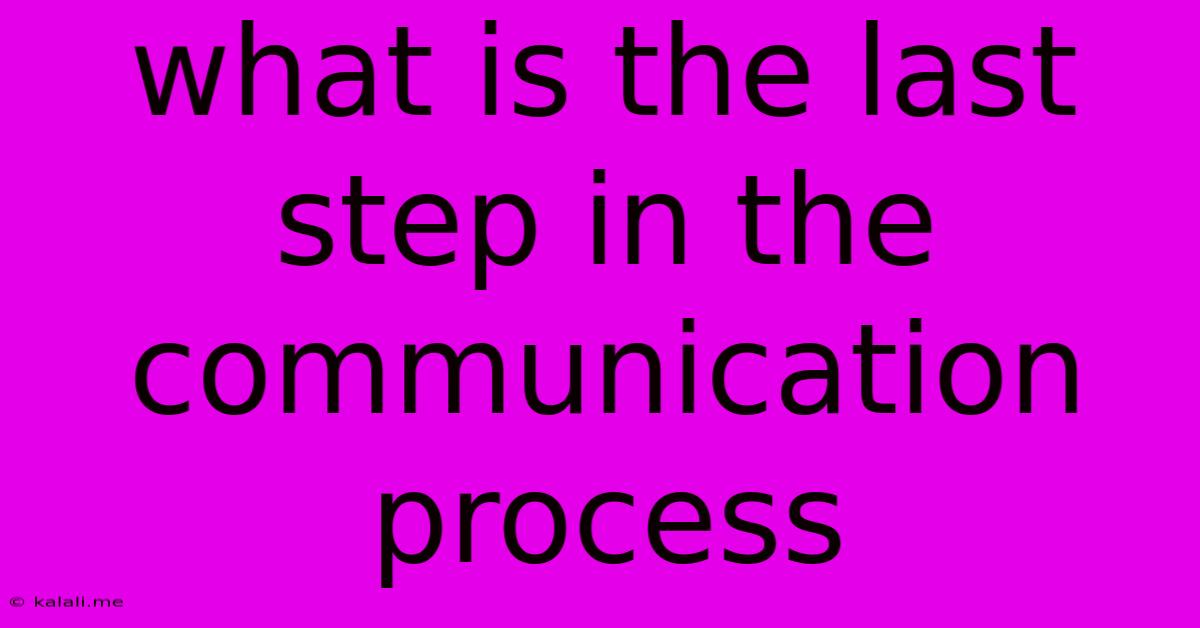What Is The Last Step In The Communication Process
Kalali
Jun 14, 2025 · 3 min read

Table of Contents
What is the Last Step in the Communication Process? Feedback: The Crucial Final Piece
The communication process isn't a one-way street; it's a dynamic exchange. While many define the steps as sender, message, channel, receiver, and decoding, feedback is the often-overlooked, yet crucial, final step that completes the cycle and determines the effectiveness of the entire communication. This article will delve into the importance of feedback and explore its various forms in different communication contexts.
Understanding the communication process holistically is essential for effective messaging, whether you're crafting a marketing campaign, delivering a presentation, or simply having a conversation. Ignoring feedback can lead to misunderstandings, missed opportunities, and ultimately, communication failure.
Understanding Feedback: More Than Just a Response
Feedback isn't simply a receiver's reply; it's a systematic response that informs the sender whether their message was received, understood, and achieved its intended purpose. It provides a vital link back to the sender, closing the loop and allowing for adjustments and refinements in future communications. This makes feedback integral to the overall success of any communication endeavor.
Think of it like this: you send an email (the message) to a colleague requesting information (the purpose). They reply with the information (the response). But is that truly the end? No. Their prompt response shows you understood your request correctly, and their provided data is the feedback loop, enabling you to proceed accordingly.
Different Forms of Feedback: Verbal and Nonverbal Cues
Feedback can manifest in many ways, both verbally and nonverbally:
-
Verbal Feedback: This includes direct responses, questions, comments, and critiques. It's the most explicit form of feedback and allows for clear understanding of the receiver's perspective. Examples include: "Yes, I understood perfectly," "I need more clarification on point X," or "This presentation was engaging and informative."
-
Nonverbal Feedback: This encompasses body language, facial expressions, and tone of voice. These cues, often subtle, can provide valuable insight into the receiver's understanding and emotional response. A nod of understanding, a furrowed brow showing confusion, or a dismissive shrug all speak volumes. Observing nonverbal cues is a critical skill in effective communication.
-
Written Feedback: Email replies, comments on social media, or reviews are all excellent examples of written feedback. This form allows for a more considered response and provides a record of the communication exchange.
Why Feedback is the Last and Most Important Step
Without feedback, the communication loop remains incomplete. The sender is left guessing the effectiveness of their message, possibly leading to repeated communication attempts or, worse, misinterpretations that hinder progress. Feedback provides:
- Confirmation of Understanding: It verifies whether the message was received and understood as intended.
- Opportunity for Clarification: It allows for questions and ensures that any ambiguities are addressed.
- Improvement of Future Communication: Analyzing feedback helps to refine communication strategies and ensure clarity.
- Building Stronger Relationships: Open communication and effective feedback fosters trust and enhances collaboration.
In conclusion, while the traditional model of the communication process may end with the receiver's decoding of the message, the true completion lies in the feedback loop. This vital step ensures effectiveness, allows for adjustments, and fosters a stronger connection between the sender and receiver. Ignoring feedback is akin to building a house without checking the foundation; it may appear complete, but its stability is severely compromised. Therefore, actively soliciting and interpreting feedback is not merely an option, but a necessity for successful communication.
Latest Posts
Latest Posts
-
Is H2po4 An Acid Or Base
Jun 15, 2025
-
The End Product Of Protein Digestion Is
Jun 15, 2025
-
The Speed Of A Printer Is Measured In
Jun 15, 2025
-
Whats The Prime Factorization Of 63
Jun 15, 2025
-
Which Statement About Green Plants Is True
Jun 15, 2025
Related Post
Thank you for visiting our website which covers about What Is The Last Step In The Communication Process . We hope the information provided has been useful to you. Feel free to contact us if you have any questions or need further assistance. See you next time and don't miss to bookmark.